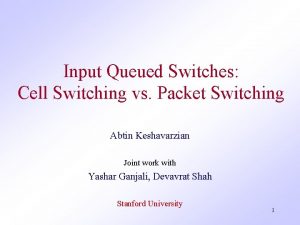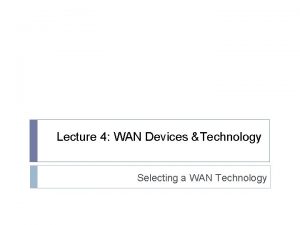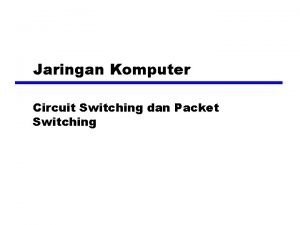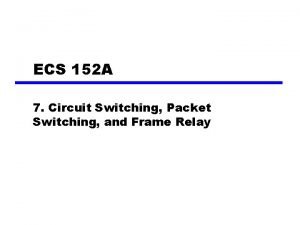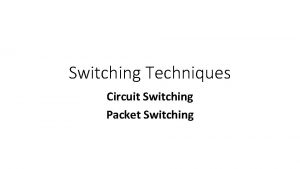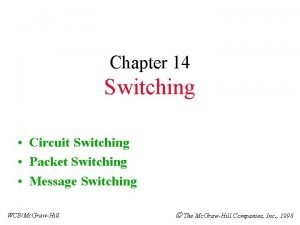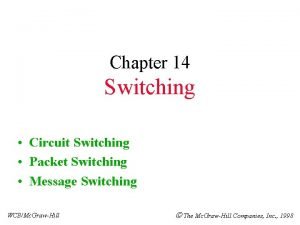Network Core Circuit Switching Endend resources reserved for










- Slides: 10

Network Core: Circuit Switching End-end resources reserved for “call” • link bandwidth, switch capacity • dedicated resources: no sharing • circuit-like (guaranteed) performance • call setup required Introduction 1 -1

The Network Core • mesh of interconnected routers • the fundamental question: how is data transferred through net? – circuit switching: dedicated circuit per call: telephone net – packet-switching: data sent thru net in discrete “chunks” Introduction 1 -2

Network Core: Circuit Switching network resources (e. g. , bandwidth) divided into “pieces” q dividing link bandwidth into “pieces” v frequency division v time division • pieces allocated to calls • resource piece idle if not used by owning call (no sharing) Introduction 1 -3

Circuit Switching: FDM and TDM Example: FDM 4 users frequency time TDM frequency time Introduction 1 -4

Numerical example • How long does it take to send a file of 640, 000 bits from host A to host B over a circuitswitched network? – All links are 1. 536 Mbps – Each link uses TDM with 24 slots/sec – 500 msec to establish end-to-end circuit Let’s work it out! Introduction 1 -5

Network Core: Packet Switching resource contention: q aggregate resource demand can exceed amount available q congestion: packets queue, wait for link use q store and forward: packets move one hop at a time v Node receives complete packet before forwarding each end-end data stream divided into packets • user A, B packets share network resources • each packet uses full link bandwidth • resources used as needed Bandwidth division into “pieces” Dedicated allocation Resource reservation Introduction 1 -6

Packet Switching: Statistical Multiplexing 100 Mb/s Ethernet A B statistical multiplexing C 1. 5 Mb/s queue of packets waiting for output link D E Sequence of A & B packets does not have fixed pattern, bandwidth shared on demand statistical multiplexing. TDM: each host gets same slot in revolving TDM frame. Introduction 1 -7

Packet-switching: store-and-forward L R R • takes L/R seconds to transmit (push out) packet of L bits on to link at R bps • store and forward: entire packet must arrive at router before it can be transmitted on next link • delay = 3 L/R (assuming zero propagation delay) R Example: • L = 7. 5 Mbits • R = 1. 5 Mbps • transmission delay = 15 sec more on delay shortly … Introduction 1 -8

Packet switching versus circuit switching Packet switching allows more users to use network! • 1 Mb/s link • each user: – 100 kb/s when “active” – active 10% of time • circuit-switching: N users 1 Mbps link – 10 users • packet switching: – with 35 users, probability > 10 active at same time is less than. 0004 Q: how did we get value 0. 0004? Introduction 1 -9

Packet switching versus circuit switching Is packet switching a “slam dunk winner? ” • great for bursty data – resource sharing – simpler, no call setup • excessive congestion: packet delay and loss – protocols needed for reliable data transfer, congestion control • Q: How to provide circuit-like behavior? – bandwidth guarantees needed for audio/video apps – still an unsolved problem (chapter 7) Q: human analogies of reserved resources (circuit switching) versus on-demand allocation (packet-switching)? Introduction 1 -10
 Message switching and packet switching
Message switching and packet switching A switched wan is normally implemented as a network
A switched wan is normally implemented as a network Advantage and disadvantages of packet switching
Advantage and disadvantages of packet switching Virtual circuit switching example
Virtual circuit switching example Cell switching vs packet switching
Cell switching vs packet switching Cell switching vs packet switching
Cell switching vs packet switching In a banyan switch micro switch
In a banyan switch micro switch Each packet is treated independently
Each packet is treated independently What is a private wan
What is a private wan Circuit switched networks
Circuit switched networks Packet
Packet




